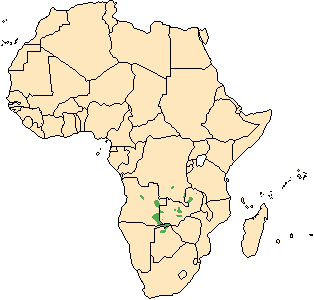![]() Return
to Artiodactyla
Return
to Artiodactyla
Classification
|
 Kobus leche
Kobus leche
Lechwe
![]()
Taxonomy
 |
 |
 |
Click on the pictures above for a larger view of the
photographs
|
||
General Characteristics
Body Length: 130-180 cm / 4.3-6 ft.
Shoulder Height: 85-110 cm / 2.8-3.6 ft.
Tail Length: 30-45 cm / 12-18 in.
Weight: 60-130 kg / 132-286 lb.The long rough, greasy coat varies in colour with subspecies: bright chestnut (Red lechwe K. l. leche), red-brown (Kafue lechwe K. l. kafuensis), or black (Black lechwe K. l. smithemani). Males generally darken with age. The underparts, neck, chin, mouth and lips are white. The black-tipped tail has a bushy white "flag" on the underside. The foreleg has a black stripe. The body is long, with the hindquarters higher than the shoulders. The hooves are long and relatively narrow, as an adaptaion to the marshy environment. The elegantly swept back horns are found only in males, and grow 45-92 cm / 18-37 in. long. They are thin and back-slanted, with upturned tips, and are ridged along most of their length.
Ontogeny and Reproduction
Gestation Period: 7-8 months.
Young per Birth: 1
Weaning: After 4 months.
Sexual Maturity: Females at 1.5 years, males at 2.5 years.
Life span: 15 years.The majority of births occur in the dry season (July-October), although breeding has been noted throughout the year. The young lie up for several week safter birth before joining their mothers.
Ecology and Behavior
As with most antelope, the lechwe has peak activity times in the morning and late afternoon. Extremely at ease in the water, animals are regularly seen grazing in shoulder-deep water. They are good swimmers, but prefer to wade while walking on boggy ground. On solid land, their long, soft hooves are a disadvantage. Therefore, as seasonal floods and draughts occur, herds move in step with the water, grazing on the periphery of the floodplain. Generally, females and their young are found in the wetter areas, with males (whether solitary or in bachelor herds) inhabiting the drier zones. As vegetation grows plentifully in the floodplain environment, lechwe population densities may be extremely high - up to 200 individuals per square kilometer is some cases. No strict social system exists, and often the only lasting bonds are between a mother and her recent offspring. Due to the constant fluctuations in their habitat, male lechwe do not hold extended territories. Instead, 'lekking' is observed, with 20-200 males defending small patches (15-200 meters in diameter) within a common 'arena'. Each of these clusters is associated with a large herd of females. The smaller, centrally located patches are prone to intense competition due to greater reproductive success, and an individual rarely holds this area for more than a few days. When disturbed lechwe flee into the water via a series of ungainly bounds.Family group: Loose mixed and single-sex herds of 400 or more animals.
Diet: Grasses, water plants.
Main Predators: Lion, leopard, cheetah, hyena, Cape hunting dog, crocodile, python.
Distribution
Floodplains bordering swamps, rivers, and marshes in south-central Africa.

Range Map (Redrawn from IEA, 1998)
Conservation Status
The lechwe is considered a low risk, conservation dependent species by the IUCN (1996). K. l. leche is classified as a low risk, conservation dependent subspecies, while both K. l. kafuensis and K. l. smithemani are vulnerable. K. l. robertsi is believed to be extinct. A major threat to lechwe is the building of hydroelectric dams which eliminates their seasonal floodplain habitat.
Remarks
The lechwe (pronounced "letsh-we" or "lesh-way") is the second most aquatic antelope after the sitatunga. Kobus (New Latin) from koba, an African name. Lechwe is a name of Bantu origin meaning an antelope.
Literature Cited
Alden, P. C., R. D. Estes, D. Schlitter, and B. McBride. 1995. National Audubon Society Field Guide to African Wildlife. New York: Chanticleer Press.IEA (Institute of Applied Ecology). 1998. Kobus leche. In African Mammals Databank - A Databank for the Conservation and Management of the African Mammals Vol 1 and 2. Bruxelles: European Commission Directorate. Available online at http://gorilla.bio.uniroma1.it/amd/amd176b.html
Kingdon, J. 1997. The Kingdon Field Guide to African Mammals. Academic Press, London and New York: NaturalWorld.
Nowak, R. M. [editor]. 1991. Walker's Mammals of the World (Fifth Edition). Baltimore: The Johns Hopkins University Press.
Walther, F. R. 1990. Reedbucks, waterbucks,.and impalas. In Grzimek's Encyclopedia of Mammals. Edited by S. P. Parker. New York: McGraw-Hill. Volume 5, pp. 448-461.
Wilson, D. E., and D. M. Reeder [editors]. 1993. Mammal Species of the World (Second Edition). Washington: Smithsonian Institution Press. Available online at http://nmnhwww.si.edu/msw/
Return to Artiodactyla

![]()
© Brent Huffman, www.ultimateungulate.com |
|
|